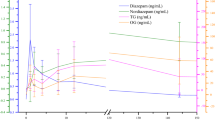Summary
6-Chloro n-butyl phthalide (CBP) was orally administered to healthy, male Wistar rats pretreated with or without 3-methylcholanthrene (3-MC) by a single dose of 150 mg/kg, and urine samples were collected for 0–24 h. The urine sample was hydrolyzed with β-glucuronidase, extracted and concentrated for TMS derivatization, and analysed on a GC-MS system for identification of CBP metabolites. Mass spectral analysis suggests that 7 CBP metabolites were present in the urine sample, and similar metabolism patterns were viewed in rats with or without pretreatment with 3-MC. Four main metabolites of CBP in rat urine were identified as α-β oxolate, β-ψ oxolate, β-hydroxylate and ψ-hydroxylate, based on their chromatographic and mass spectral properties. Two hydroxylates have been previously identified in CBP metabolism by rat liver microsomes. The other two metabolites with higher polarity were tentatively identified as dihydroxylation products on the n-butyl side chain by the mass spectra of their TMS derivatives. One minor metabolite was found by the isotopic effect of chlorine, but its specific structure was undetermined. The difference between in vivo and in vitro metabolic profiles of CBP is also discussed.
Similar content being viewed by others
References
Yu S.R., You S.Q. (1984): The pharmacological actions of 3-n-butyl phthalide (AG-1). Acta Pharm. Sinica (Chinese), 19, 486–490.
Feng Y.P., Hu D., Zhang L.Y. (1995): Effect of dl-3-n-butyl phthalide (NBP) on mouse brain energy metabolism in complete brain ischemia induced by decapitation. Acta Pharm. Sinica (Chinese), 30, 741–744.
Yang J.S., Cheng Y.W. (1984): Isolation and identification of anticonvulsant constituents inApium graveolens Chinese Pharm. Bull., 31, 671–672.
Guo Z.R., Chu F.M., Yang G.Z., (1996): Studies on synthesis and QSAR of n-butyl phthalide analogues with anticonvulsant action. In press.
Peng S.H, Zhou T.H. (1996): Structure-metabolism relationship of n-butyl phthalide and its analogues in rat hepatic microsomes. In press.
Peng S.H., Zhou T.H. (1994): Studies on the metabolism of CBP by rat liver microsomes. J. Yunan University (Natural Sciences Edition, Supplement) 16, 92–93.
Mitchell J.R., Horning M.G. (1984): Drug Metabolism and Drug Toxicology. New York, Raven Press.
Peng S.H., Zhou T.H. (1995): The study on in vitro metabolism of n-butyl phthalide by GC/MS. Chinese Chem. Lett., 6, 55–58.
Author information
Authors and Affiliations
Rights and permissions
About this article
Cite this article
Peng, S.H., Zhou, T.H. Metabolism of 6-chloro n-butyl phthalide in rat. European Journal of Drug Metabolism and Pharmacokinetics 21, 339–344 (1996). https://doi.org/10.1007/BF03189736
Received:
Issue Date:
DOI: https://doi.org/10.1007/BF03189736




